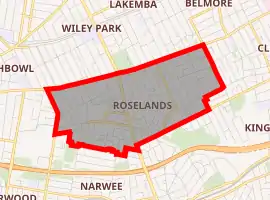Roselands, New South Wales
Roselands is a suburb in south-western Sydney, in the state of New South Wales, Australia. Roselands is located 16 kilometres south-west of the Sydney central business district in the City of Canterbury-Bankstown.
| Roselands Sydney, New South Wales | |||||||||||||||
|---|---|---|---|---|---|---|---|---|---|---|---|---|---|---|---|
 King Georges Road, Roselands Shopping Centre entrance | |||||||||||||||

| |||||||||||||||
| Population | 11,579 (2016 census)[1] | ||||||||||||||
| Established | 1987 | ||||||||||||||
| Postcode(s) | 2196 | ||||||||||||||
| Location | 16 km (10 mi) SW of Sydney CBD | ||||||||||||||
| LGA(s) | City of Canterbury-Bankstown | ||||||||||||||
| State electorate(s) | |||||||||||||||
| Federal Division(s) | Watson | ||||||||||||||
| |||||||||||||||
| 🌍 |
Geography
Roselands lies in the Cooks River watershed. The soil is clay, based on Wianamatta shale and is on the eastern edge of the great Cumberland Plain which extends westward to the Hawkesbury River and into the Blue Mountains. The topography is low rolling hills. Before settlement, the vegetation was open eucalypt woodland.
History
Aboriginal
The first inhabitants of surrounding areas were Australian Aboriginals who arrived about 40,000 years ago. At the time of British settlement in 1788 the inhabitants were Aborigines of the Darug language group and they called themselves Kuri or Koori. Land grants by the new colonial government began in about 1810.
European
This area was originally part of the suburb of Punchbowl and still shares its postcode of 2196. H.R. Morgan was granted land in the area in 1842. John Fenwick bought 100 acres (0.40 km2) in about 1880 from Matthew Norman in the area between Canterbury, Canarys and Bonds Roads. He built Belmore House on this land, which was demolished for the construction of Roselands Shopping Centre. The closest railway line was built to the neighbouring suburb of Belmore in 1895 and extended to Bankstown in 1909.
The suburb takes its name from the plant nursery that originally occupied the land. Later a golf course was built with same name which was taken over to build the shopping centre. It became a suburb on 9 February 1987, after some years of agitation by local residents and members of parliament.[2]
Commercial area
Roselands Shopping Centre was the third fully enclosed shopping precinct in Australia, opened in October 1965 (predated by Monaro Mall [March 1963] in Canberra and Miranda Fair [March 1964] in Sydney). Older open-air shopping precincts in Australia included Chermside Drive-in Shopping Centre (May 1957) in Brisbane, Top Ryde Drive-in Shopping Centre (November 1957) in Sydney, Chadstone Shopping Centre [October 1960] in Melbourne and Warringah Mall (April 1963) in Sydney.
Roselands was built on the site of a golf course. It boasted a large Grace Bros Department Store (now Myer), a single movie cinema, an indoor rainfall water feature (the 'raindrop fountain'), tennis courts and the first food court in Australia (Four Corners, demolished in 2000, remade as the Raindrop Food Court in December 2000). Many local bus services were diverted to service the new shopping centre upon its opening, but the centre was primarily designed for the age of the automobile with plenty of parking as it was distant from any railway stations. It has since had many upgrades although it remains smaller than other Sydney shopping centres.
Transport
King Georges Road is the main road through Roselands. It is a ring road which connects the northern suburbs of Sydney and the north coast motorways of New South Wales to the southern beaches of Sydney and the south coast motorways of New South Wales. King Georges Road also connects Roselands to the M5 South Western Motorway which links to Sydney's International Airport (15 minutes drive east) and west to Canberra and Melbourne.
Sport and recreation
The Lantern Club is located in Roselands Avenue. Roselands Aquatic Centre is located in Centre Avenue, opposite the shopping centre. Roselands soccer club is located at Bennett Park.
Demographics
According to the 2016 Census, 44.5 per cent of Roselands residents stated they had been born overseas. Lebanon was the birthplace of the most foreign-born residents in Roselands at 5 per cent, followed by those born in People's Republic of China at 3.8 per cent.[3]
In terms of ethnicity, the largest group in 2016 were those claiming Greek ancestry with 12.4 per cent of the responses, followed by those claiming Lebanese background at 12.3 per cent, and thirdly by those claiming Australian descent with 11.3 per cent.[3]
English only is the most common home language in Roselands, used by a plurality of 35.9 per cent of residents, followed by Arabic — the home language of 16.6 per cent — and Greek spoken by 12.2 per cent at home.[3]
According to the census, Christianity was the most followed faith in Roselands with 60.5 per cent of residents reporting that they were Christian. However, Christians in the area belong to many denominations, with the largest proportions being Catholic at 24.3 per cent, Orthodox with 17.3 per cent. Islam is the second largest religious group, accounting for 18.8 per cent of residents.[3]
Politics
Roselands is in the state electorates of Lakemba and Canterbury, both of which are safe Labor seats.
Gallery
 Memorial, Roselands Avenue
Memorial, Roselands Avenue Roselands Shopping Centre
Roselands Shopping Centre Roselands Shopping Centre
Roselands Shopping Centre Roselands Bowling Club ((Old clubhouse demolished, replaced by Lantern Club) Poker Machine Club)
Roselands Bowling Club ((Old clubhouse demolished, replaced by Lantern Club) Poker Machine Club) Unused Water Fountain, Roselands Avenue
Unused Water Fountain, Roselands Avenue
References
- Australian Bureau of Statistics (27 June 2017). "Roselands (State Suburb)". 2016 Census QuickStats. Retrieved 11 April 2018.

- History of Canterbury suburbs - Roselands
- Roselands 2016 Census statistics Australian Bureau of Statistics
External links
| Wikimedia Commons has media related to Roselands, New South Wales. |